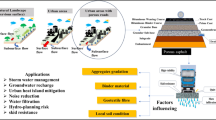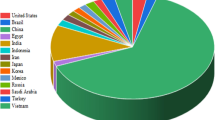Abstract
Applying foamed warm-mix asphalt in pavement has attracted great attention, but its effects on asphalt mastic are not clear. This research investigated and compared the performance characterization of asphalt mastic prepared by foamed and unfoamed binders. The functional group information, thermal behavior, and rheological characteristics were explored using a series of experiments. Results show that both foamed and unfoamed asphalt mastics have similar function groups, which indicates that foaming process does not change the infrared absorption structure of asphalt mastic. Besides, asphalt foaming seems not affect the thermal stability of mastic, although some foaming water is still present. The high- and low-temperature performances of asphalt mastic were slight weaken by foaming water, but the effect is not significant based on the analysis of variance. The asphalt–aggregate interaction of asphalt mastic is significantly improved by the foaming behavior. This study concluded that foamed asphalt mastic could achieve the similar performances with unfoamed asphalt mastic.












Similar content being viewed by others
References
Rughooputh R, Beeharry R, Qasrawi H. Warm mix asphalt for better sustainability under tropical climate. Int J Pavement Eng. 2020;21(1):1–8.
Zhang F, Hu C, Zhang Y. The effect of PPA on performances and structures of high-viscosity modified asphalt. J Therm Anal Calorim. 2018;134(3):1729–38.
Liu S, Yu X, Dong F. Evaluation of moisture susceptibility of foamed warm asphalt produced by water injection using surface free energy method. Constr Build Mater. 2017;131:138–45.
Hasan MRM, You Z, Yang X. A comprehensive review of theory, development, and implementation of warm mix asphalt using foaming techniques. Constr Build Mater. 2017;152:115–33.
Bairgi BK, Mannan UA, Tarefder RA. Tribological approach to demonstrate workability of foamed warm-mix asphalt. J Mater Civ Eng. 2019;31(9):04019191.
Hailesilassie BW, Hugener M, Partl MN. Influence of foaming water content on foam asphalt mixtures. Constr Build Mater. 2015;85:65–77.
Bairgi BK, Tarefder RA, Ahmed MU. Long-term rutting and stripping characteristics of foamed warm-mix asphalt (WMA) through laboratory and field investigation. Constr Build Mater. 2018;170:790–800.
Wu S, Zhang W, Shen S, et al. Field performance of foaming warm mix asphalt pavement. Transp Res Rec. 2019;2673(3):281–94.
Huang M, Wen X, Wang L. Influence of foaming effect, operation time and health preserving properties of foam epoxy asphalt mixtures. Constr Build Mater. 2017;151:931–8.
Abbas AR, Nazzal M, Kaya S, Akinbowale S, Subedi B, Arefin MS, et al. Effect of aging on foamed warm mix asphalt produced by water injection. J Mater Civ Eng. 2016;28(11):04016128.
Newcomb DE, Arambula E, Yin F, Zhang J, Bhasin A, Li W et al. Properties of foamed asphalt for warm mix asphalt applications. NCHRP Report, 807. Washington D.C., 2015.
Xiao F, Punith VS, Putman BJ. Effect of compaction temperature on rutting and moisture resistance of foamed warm-mix-asphalt mixtures. J Mater Civ Eng. 2013;25(9):1344–52.
Liu S, Peng A, Zhou S, Meng H. Effect of foaming water on rheological and microscopic properties of foamed warm-mix asphalt binders. J Transp Eng Part B Pavements. 2019;145(3):04019019.
Ali A, Abbas AR, Nazzal MD, Alhasan A, Roy A, Powers D. Effect of temperature reduction, foaming water content, and aggregate moisture content on performance of foamed warm mix asphalt. Constr Build Mater. 2013;48:1058–66.
Zhou SB, Liu S, Xiang Y. Effects of filler characteristics on the performance of asphalt mastic: a statistical analysis of the laboratory testing results. Int J Civ Eng. 2017. https://doi.org/10.1007/s40999-017-0272-x.
Pei J, Fan Z, Wang P, Zhang J, Xue B, Li R. Micromechanics prediction of effective modulus for asphalt mastic considering inter-particle interaction. Constr Build Mater. 2015;101:209–16.
Guo M, Tan Y, Yu J, Hou Y, Wang L. A direct characterization of interfacial interaction between asphalt binder and mineral fillers by atomic force microscopy. Mater Struct. 2017;50(2):141.
Tan YQ, Li ZH, Zhang XY, Dong ZJ. Research on high and low-temperature properties of asphalt–mineral filler mastic. J Mater Civ Eng. 2010;22(8):811–9.
Guo M, Bhasin A, Tan Y. Effect of mineral fillers adsorption on rheological and chemical properties of asphalt binder. Constr Build Mater. 2017;141:152–9.
Ma X, Chen H, Zhang X, et al. Effect of asphalt binder characteristics on filler-asphalt interactions and asphalt mastic creep properties. J Mater Civ Eng. 2019;31(8):04019138.
Roberto A, Romeo E, Montepara A, et al. Effect of fillers and their fractional voids on fundamental fracture properties of asphalt mixtures and mastics. Road Mater Pavement Des. 2020;21(1):25–41.
Del Carmen RM, Moreno F, Martínez-Echevarría MJ, et al. Comparative analysis of emissions from the manufacture and use of hot and half-warm mix asphalt. J Clean Prod. 2013;41:1–6.
Shiva Kumar G, Suresha SN. State of the art review on mix design and mechanical properties of warm mix asphalt. Road Mater Pavement Des. 2019;20(7):1501–24.
Frolov IN, Okhotnikova ES, Ziganshin MA, et al. The study of bitumen by differential scanning calorimetry: the interpretation of thermal effects. Pet Sci Technol. 2019;37(4):417–24.
Xia W, Xu T, Wang H. Thermal behaviors and harmful volatile constituents released from asphalt components at high temperature. J Hazard Mater. 2019;373:741–52.
Xia W, Xu T, Wang H, et al. Combustion kinetics of asphalt binder components and the release processes of gaseous products. Combust Flame. 2019;206:322–33.
Xu T, Wang Y, Xia W, et al. Effects of flame retardants on thermal decomposition of SARA fractions separated from asphalt binder. Constr Build Mater. 2018;173:209–19.
Zanoni MAB, Rein G, Yermán L, et al. Thermal and oxidative decomposition of bitumen at the microscale: kinetic inverse modelling. Fuel. 2020;264:116704.
Zhang F, Hu C, Zhang Y. Influence of montmorillonite on ageing resistance of styrene–ethylene/butylene–styrene-modified asphalt. J Therm Anal Calorim. 2018;133(2):893–905.
Shi S, Shen D, Xu T. Programming effects on thermal decomposition of shape memory polymer-based composites. J Therm Anal Calorim. 2017;130(3):1953–60.
Xing B, Fan W, Han L, et al. Effects of filler particle size and ageing on the fatigue behaviour of bituminous mastics. Constr Build Mater. 2020;230:117052.
Zhang J, Liu G, Hu Z, Zhu C, Pei J, Jin L. Effects of temperature and loading frequency on asphalt and filler interaction ability. Constr Build Mater. 2016;124:1028–37.
Liu G, Zhao Y, Zhou J, Li J, Yang T, Zhang J. Applicability of evaluation indices for asphalt and filler interaction ability. Constr Build Mater. 2017;148:599–609.
Liu S, Zhou S, Peng A, et al. Investigation of physiochemical and rheological properties of waste cooking oil/SBS/EVA composite modified petroleum asphalt. J Appl Polym Sci. 2019. https://doi.org/10.1002/app.48828.
Liu S, Peng A, Zhou S, Wu J, Xuan W, Liu W. Evaluation of the ageing behaviour of waste engine oil-modified asphalt binders. Constr Build Mater. 2019;223:394–408.
Liu S, Zhou S, Peng A. Evaluation of polyphosphoric acid on the performance of polymer modified asphalt binders. J Appl Polym Sci. 2019. https://doi.org/10.1002/app.48984.
Tan Y, Li X, Wu J. Internal influence factors of asphalt–aggregate filler interactions based on rheological characteristics. J Mater Civ Eng. 2012;24(12):1520–8.
Acknowledgements
The research presented herein was sponsored by the National Natural Science Foundation of China (51908194), the Fundamental Research Funds for the Central Universities (2019B13214), the China Postdoctoral Science Foundation Project (2019M650101, 2018M633617XB), the Guangxi Natural Science Foundation Program (2018GXNSFAA281339), the Key Research and Development Program of Jiangxi (20192BBG70080), the Nanning Science and Technology Base Project (20185071-1), and the Nanning Key Research and Development Program (20183044-1).
Author information
Authors and Affiliations
Corresponding author
Additional information
Publisher's Note
Springer Nature remains neutral with regard to jurisdictional claims in published maps and institutional affiliations.
Rights and permissions
About this article
Cite this article
Liu, S., Zhou, S. & Peng, A. Comparison of performance characterization of asphalt mastic prepared by foamed and unfoamed asphalt binders. J Therm Anal Calorim 144, 657–669 (2021). https://doi.org/10.1007/s10973-020-09507-z
Received:
Accepted:
Published:
Issue Date:
DOI: https://doi.org/10.1007/s10973-020-09507-z




